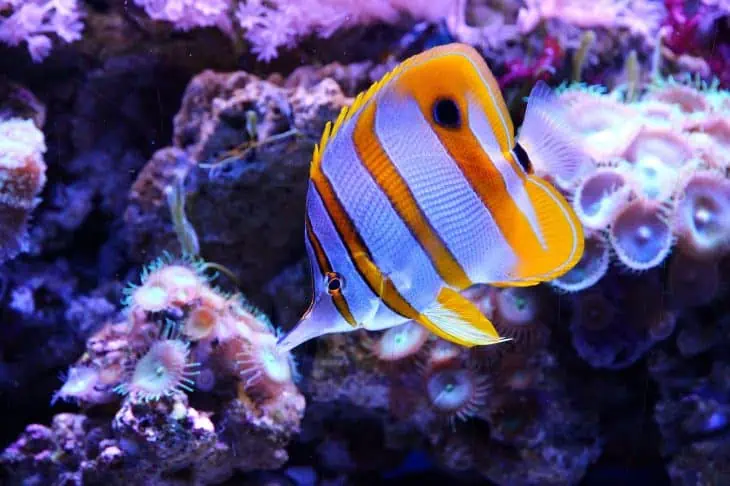
The butterflyfish has been traded by people for aquarium displays. Its body shape and distinctive color patterns have been an eye-catcher in a controlled environment together with other ornamental fishes. In its natural habitat, the butterflyfish is highly territorial and monogamous, meaning it only goes singly or in pairs, inhabiting shallow waters around coral reefs.
As adults, they are white with strong black vertical stripes and yellow highlights on their fins, while juveniles are distinctly darker colors and have an eyespot on their dorsal fins to confuse predators. Truly, butterflyfish are unique in terms of a lot of things compared to other fishes, and if you want to know more about them, then here are some facts that would surely satisfy your growing interest in them.
- The butterflyfish are a group of conspicuous tropical marine fish of the family Chaetodontidae.
- Butterflyfish look like smaller versions of angelfish, Pomacanthidae, but they lack preopercle spines at the gill covers.
- A butterflyfish mostly range from 12 to 22 cm (4.7 to 8.7 in) in length.
- The two largest of the species, the lined butterflyfish and the saddle butterflyfish, C. ephippium, grow up to 30 cm. The common name references the brightly colored and strikingly patterned bodies of many species, bearing shades of black, white, blue, red, orange, and yellow.
- Many have eyespots on their flanks and dark bands across their eyes, not unlike the patterns seen on butterfly wings.
- They have deep, laterally narrow bodies that can be noticed through the profusion of reef life.
- The butterflyfish has a conspicuous coloration intended for interspecies communication.
- These corallivores are especially territorial, forming pairs and staking claim to a specific coral head.
- Their coloration also makes them popular aquarium fishes.
- Most species feed on coral polyps and sea anemones.
- Butterflyfish are pelagic spawners. They release many buoyant eggs into the water, which become part of the plankton, floating with the currents until hatching.
- Hybrids are rare in nature, but butterflyfishes are the most likely reef fish to breed with other species.
- Butterflyfishes produce several sounds to ward off members of the same species or aid communication between a pair.
- Butterflyfishes that feed on coral polyps tend to be monogamous; the male defends the pair’s territory, allowing the female to feed.
- If you see a large number of butterflyfishes on a dive, that’s a good sign for the coral reef. These fishes require large areas of healthy coral for food, and changes in their populations can be indicative of wider issues.
- The butterflyfish can live up to 7 years in the wild and up to 10 years in a well-kept aquarium.
- The jaws of some butterflyfishes can measure more than 25% of their body length.
- Butterflyfishes generally stay in groups unless they are a particularly territorial species. A solitary butterflyfish is usually traveling in search of a mate. It is one of the very few fish that finds a mate who they hunt with, live, and travel together for life.
- Moray eels, snappers, and groupers are the main predators of butterflyfish.
- The family name “Chaetodontidae” derives from the Ancient Greek words χαιτέ, chaite (hair) and οδοντος, odontos (tooth).
Was this page helpful?
Our commitment to delivering trustworthy and engaging content is at the heart of what we do. Each fact on our site is contributed by real users like you, bringing a wealth of diverse insights and information. To ensure the highest standards of accuracy and reliability, our dedicated editors meticulously review each submission. This process guarantees that the facts we share are not only fascinating but also credible. Trust in our commitment to quality and authenticity as you explore and learn with us.
